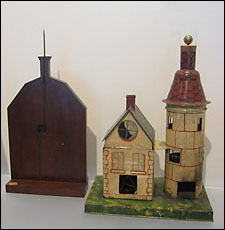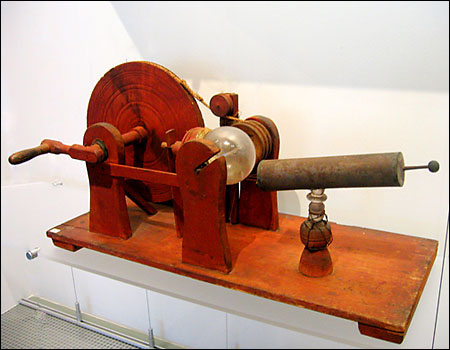‘A How-To Guide’ explores Ben Franklin’s ‘can-do’ legacy
Self-help guru Benjamin Franklin’s machines on show
Benjamin Franklin knew how to get things done: He was an inventor and scientist, printer and politician, writer and thinker. Not surprisingly, he managed all this in the 18th century, a time when a wide variety of printed materials and technical instruments gave intellectuals and the general public unprecedented access to information about science, technology, geographic exploration, politics, music, and religion. Armed with little formal education, Franklin consumed the increasingly available knowledge of his time and generated a lot himself. His legacy reflects a “how-to” nature that helps explain his great contributions to so many areas.

This idea forms the basis for a new joint exhibit at Harvard’s Houghton Library and the Collection of Historical Scientific Instruments (CHSI) that celebrates the 300th anniversary of Franklin’s birth. “Benjamin Franklin: A How-To Guide” features books, pamphlets, broadsides, and scientific instruments, some owned and used by Franklin and others that influenced him and informed his life and work.
Franklin grew up reading what we might today term “how-to” literature, books that taught skills like swimming and letter writing, and dealt with subjects like diets and science. “Franklin was a voracious reader. He kept up with what was going on in the world, especially with what we now call science or natural history,” said Thomas Horrocks, associate librarian for Collections at Houghton and co-curator of the exhibit.
As an adult, Franklin piled up accomplishments in a great many fields, from observing nature; devising experiments (with electricity, most famously); writing books, pamphlets, and encyclopedias; politicking in the United States and abroad; and, not least, helping America gain independence from Great Britain.
What’s more, he sought to make information accessible both through his own writings and the work of others. And he aimed for a wide public. His popular Poor Richard’s Almanac, printed for years, didn’t require overly educated readers. Part of his genius can be seen in his sayings: The ideas weren’t necessarily his, but he reworked them and made them so pithy that they live today.
The exhibition at Houghton Library runs June 5-Sept. 23. Hours: Monday, Wednesday, Thursday, Friday 9 a.m.-5 p.m.; Tuesday 9 a.m.-8 p.m., Saturday 9 a.m.-1 pm. For details, call Thomas Horrocks at (617) 495-2442. The exhibition at the Collection of Historical and Scientific Instruments runs June 5-Dec. 22. Hours: Monday-Thursday, 11 a.m.-4 p.m. For details, call (617) 495-2779.
The Harvard exhibition consists of two parts. The first, housed in Houghton Library, tackles the “Circulation of Knowledge” – what does one know, and how does one know it? – and offers 60-plus writings and scientific instruments that Franklin read, used, wrote, or was influenced by. There’s a wide variety of materials for viewing. Items Franklin printed are included: the New England Courant, where Franklin apprenticed; his Plain Truth, a call-to-arms pamphlet that told Colonists how to organize a militia; and Poor Richard Improved, the 1748 edition of his popular almanac with advice on things like weather and health.
There are also, of course, items from Franklin’s political career, with highlights such as the Declaration of Independence – one of only 25 copies known to exist – and the appointment and instructions he received when he was sent to Paris to secure aid for and recognition of the United States.
Franklin’s displayed writings include “Experiments and Observations on Electricity” as well as his scientific writings translated into French, German, and Italian – Franklin was well-respected on the Continent, one reason he was successful in politics.
Eighteenth century scientific instruments also feature prominently – items like those Franklin used in his own experiments. Examples include a ring dial that uses the position of the sun to determine the time; an orrery, which showed the movements of the planets within the solar system; and a Lieberkühn compass microscope.
“Franklin himself was a very curious person,” said Horrocks. “He questioned everything, which led him to perform experiments of his own. This was not uncommon – there were a lot of amateur scientists in the 18th century.”
A lot of those amateurs worked together – Franklin liked the power science had to bring people together. This idea of “Science and Sociability” provides the focus for the second portion of the exhibit at CHSI, curated by Sara Schechner, David P. Wheatland Curator. Here, 18th century scientific instruments, rare books, and letters are used to illustrate that science was a social activity involving collaboration and audiences.
Featured CHSI objects include “electrical machines” – which are what they sound like, machines that generated electricity to power other machines. One such generator on display, a large one made in London circa 1765, was purchased by Franklin on behalf of Harvard to replace equipment lost when Harvard Hall burned down in 1764. Resembling a great bed with headboard and footboard, the instrument has a large flywheel that rotates a glass cylinder against a cushion to generate electricity. Such a machine was used for cutting-edge science experiments as well as party games in which a lady might draw an “electrical kiss” from a charged-up gentleman. Social activities, indeed.

Also on display is a “village” of thunder houses that were used in Harvard classes, some bought with Franklin’s help. A thunder house was a miniature house (small enough to sit on a desk) that Franklin designed as proof of the effectiveness of his lightning rod. A demonstrator would place gunpowder inside the thunder house and then charge his electric machine so that it drew a spark to a miniature lightning rod on the thunder house. If the lightning rod was grounded, nothing happened. If it wasn’t, the gunpowder would ignite, blowing off the roof and collapsing the walls with a bang.
For Franklin, science and knowledge transcended politics and war. Despite the American Revolution, he continued to be friendly with his scientific cohorts in Great Britain. “Benjamin Franklin: A How-To Guide” examines the tools Franklin had at his disposal and how he put them to good use. Whether scientific or political, using his own ideas or others, the self-taught Franklin stands as a paragon of knowledge, its dissemination, and how to get things done.
A final note: Included in the Houghton display is Franklin’s autobiography: Franklin’s own how-to guide to himself.




